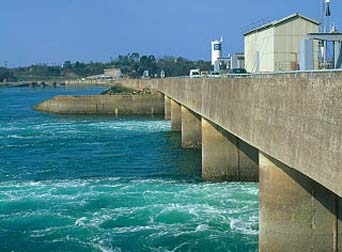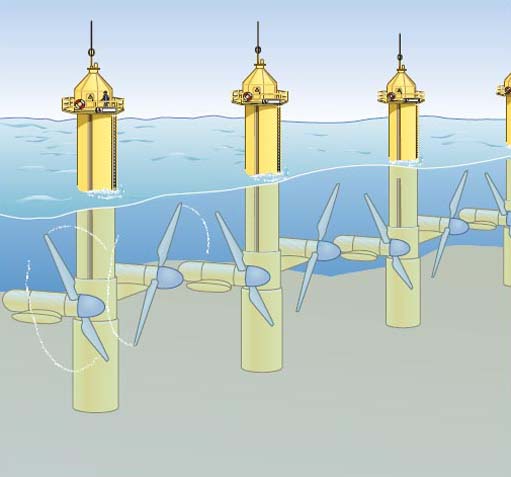4.3 Non-solar renewables
4.3.1 Tidal Energy
The energy that causes the slow but regular rise and fall of the tides around our coastlines is not the same as that which creates waves. It is caused principally by the gravitational pull of the moon on the world's oceans. The sun also plays a minor role, not through its radiant energy but in the form of its gravitational pull, which exerts a small additional effect on tidal rhythms.
The principal technology for harnessing tidal energy essentially involves building a low dam, or barrage, across the estuary of a suitable river. The barrage has inlets that allow the rising sea levels to build up behind it. When the tide has reached maximum height, the inlets are closed and the impounded water is allowed to flow back to the sea in a controlled manner, via a turbine-generator system similar to that used in hydroelectric schemes.
The world's largest tidal energy scheme is at La Rance in France, which has a capacity of 240 MW.

There are a few other, smaller, tidal plants in various countries, including Canada, Russia and China. The United Kingdom has one of the world's best potential sites for a tidal energy scheme, in the Severn Estuary. If built, its capacity would be around 8600 MW, much larger than any other single power plant, and it could provide about 6 per cent of current UK electricity demand. But the scheme has not yet been implemented, mainly due to its very high capital cost and concerns about the effects on wildlife in the Severn estuary.
Another, newer tidal energy technology involves the use of underwater turbines (rather like submerged wind turbines) to harness the strong tidal and oceanic currents that flow in certain coastal regions. A 10 kW prototype tidal current turbine was tested at Loch Linne, in Scotland, in 1994, and a larger, 300 kW prototype was tested off the Devon coast in 2002.
The technology is still under development, but its prospects are promising.

